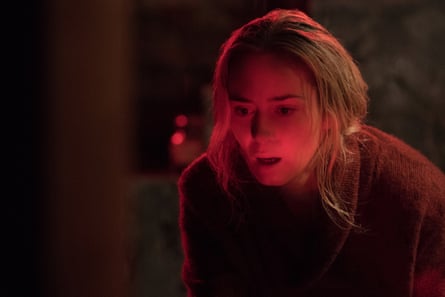The B-movie, in the traditional sense of the term, doesn’t really exist any more. The genre was named to describe films forming the trashier, less-anticipated second half of a double feature: with those mostly gone the way of the drive-in, anything we now call a “B-movie” can only be the main attraction, a second-class A-movie, looking at the gutter from the stars. For the term persists, not just with reference to low-budget genre or exploitation cinema, but to major-league studio productions made in the same spirit of carefree scrappiness.
Which brings us to Rampage, a sweaty, lunkish slab of lowbrow escapism starring the former wrestler Dwayne “The Rock” Johnson as a primatologist fending off an attack of giant, genetically mutated beasts with the help of a super-sized gorilla. Every word of that gleefully ludicrous premise screams B-movie; ditto its gleefully simplistic tagline, “Big Meets Bigger”. Critical responses have ranged from “dumb” to “winningly dumb”, and it’s fair to say the makers of Rampage weren’t aiming for anything else, even from their target audience: the film’s wink-wink stupidity is part of the CGI-heavy package.
Yet where the term “B-movie” typically goes hand-in-hand with a low budget, Rampage – to paraphrase Dolly Parton – cost a lot of money to look this cheap and cheerful. A hundred and twenty million dollars, to be exact. It opens days after the trailer for Jason Statham’s latest rumpus, The Meg, got Film Twitter in a tizz of semi-ironic excitement: the Stath! Battling a giant megalodon shark! In 3D! If true B-movies should be able to be pitched entirely with exclamation marks, The Meg certainly passes the test. Yet despite clearly building on the hyperbolic nonsense plotting (“It’s the largest shark that ever existed!”) and camp appeal that briefly made internet phenomena of such genuine low-rent productions as Sharknado or Mega Shark vs Giant Octopus, The Meg comes with a $150m price tag.
In the 40-plus years since audiences were luridly thrilled by Steven Spielberg’s modestly scaled Jaws, now the granddaddy of all canny B-movies launched beyond their supposed station by craft, wit and a fair commercial wind, the genre it minted has become at once cheaper and a lot more expensive. Rampage and The Meg are themselves oversized, genetically mutated creatures, inflated far beyond its humble, quick-and-dirty roots to varnished blockbuster status.
That’s no new development: after all, in a mainstream cinema scene currently dominated by comic-book heroes and franchise models, genres and formats that were once the preserve of those lower-lit second features have become Hollywood’s priority. Some have stayed more in touch with their junkyard roots than others. You wouldn’t call Christopher Nolan’s sternly styled, serious-minded Batman films B-movies – not to their tense-jawed face, at least – but Taika Waititi’s impish, knowingly silly Thor: Ragnarok more happily cops to its DNA.
This year, however, has shown that DNA to be present in films of all scales and sizes, from the multiplex to the arthouse. Steven Soderbergh, US cinema’s most unpredictable auteur, tricked out a shlockily old-fashioned gaslight-thriller format with a scuzzy iPhone aesthetic and sharp gender commentary in Unsane, and got a lofty Berlin film festival premiere for his trouble. Currently performing above expectations at the top of the box office, John Krasinski’s A Quiet Place is in many ways a truer update of the old-school B-movie sensibility than a hulking colossus like Rampage: produced for just $17m, it’s a small-scale, resourcefully produced, crackingly effective horror film with a simple, faintly ludicrous premise at its core. An unexplained plague of deadly alien invaders, responsive only to sound, preying on a wholesome American family – you can imagine a version of this playing at the bottom of the bill in the 1950s, albeit perhaps with less emo family drama attached.

That A Quiet Place is, beyond its loopy alien antics, emotionally stirring and executed with lean formal elegance has made it a hit with critics – many of whom have taken Krasinski’s own cue in labelling it an “elevated horror” movie, an increasingly ubiquitous term intended to dignify genre films with noble artistic aspirations. But it’s an objectionable turn of phrase, implying a certain intrinsically lowly or shameful status to genre film-making in itself: there are good horror movies and bad ones, smart horror movies and stupid ones, and the critical distinction seems clear enough without needing to delineate and elevate a separate subgenre on the basis of class and quality alone. As the critic April Wolfe pointed out on Twitter, “It’s OK to say it’s horror … I don’t say ‘elevated drama’ to distinguish which dramas I like and don’t like.”
That this talk of “elevation” happens at all is evidence that B-cinema hasn’t lost its stigma of artistic disrepute, though the imagined hierarchy is crumbling in interesting ways. This year’s best picture Oscar, after all, went for the first time to a science-fiction film of sorts, Guillermo del Toro’s adoring monster-movie homage The Shape of Water – beating, among others, Get Out, Jordan Peele’s wickedly playful collision of old-school horror with brisk, bracing racial politics. (Yep, that got the “elevated” tag, too.) Del Toro’s film is a curious mash-up of romantic prestige trappings and grisly genre jolts that affectionately borrows narrative and design elements from the 1954’s The Creature from the Black Lagoon. That schlock classic wouldn’t have come within a hundred miles of the Academy Awards in its day; now, in an indirect, multi-mirrored way, even the old guard is seeing the beauty in the B-movie muck.

Comments (…)
Sign in or create your Guardian account to join the discussion